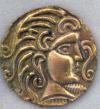2-3 Billion Years Ago, Star Formation Was Bursting in The Milky Way

A team led by researchers of the Institute of Cosmos Sciences of the University of Barcelona (ICCUB, UB-IEEC) and the Besançon Astronomical Observatory have found, analysing data from the Gaia satellite, that a severe star formation burst occurred in the Milky Way about to and three thousand million years ago. In this process, more than 50 % of the stars that created the galactic disc may have been born. There results come from the combination of the distances, colors and magnitude of the stars that were measured by Gaia with models that predict their distribution in our Galaxy. The study has been published in the journal Astronomy & Astrophysics.
Just like a flame fades when there is no gas in the cylinder, the rhythm of the stellar formation in the Milky Way, fuelled by the gas that was deposited, should decrease slowly and in a continuous way until using up the existing gas. The results of the study show that, although this was the process that took place over the first 4,000 million years of the disc formation, a severe star formation burst, or “stellar baby boom” –as stated in the article published in the Nature Research Highlights-, inverted this trend. The merging with a satellite galaxy of the Milky Way, which is rich in gas, could have administrated new fuel and reactivate the process of stellar formation, in a similar way to when a gas cylinder is changed. This mechanism would explain the distribution of distances, ages and masses that are estimated from the data taken from the European Space Agency Gaia satellite.
“The time scale of this star formation burst together with the great amount of stellar mass involved in the process, thousands of millions of solar mass, suggests the disc of our Galaxy did not have a steady and paused evolution, it may have suffered an external perturbation that began about five billion years ago”, said Roger Mor, ICCUB researcher and first signer of the article.
“We have been able to find this out due having –for the first time- precise distances for more than three million stars in the solar environment”, says Roger Mor. “Thanks to these data –he continues- we could discover the mechanisms that controlled the evolution more than 8-10 billion years ago in the disc of our Galaxy, which is not more than the bright band we see in the sky on a dark night and with no light pollution”.
Distribution of 3 million stars used in this stdy to detect the star formation burst from 2-3 billion years ago. Gaia provided the distance for each of these objects on the gallactic disc. Below, a scheme of the spiral arms of the Milky Way.
Credit; University of Barcelona
According to the expert on simulations of galaxies similar to the Milky Way, Santi Roca-Fàbrega –from the Complutense University of Mardid and also signer of the article, “the obtained results match with what the current cosmological models predict, and what is more –he continues- our Galaxy seen from Gaia’s eyes is an excellent cosmological laboratory where we can test and confront models at a bigger scale in the universe”.
Gaia mission until 2020
This study has been conducted with the second release of the Gaia mission, which was published a year ago, on April 25, 2018. Xavier Luri, director of ICCUB and also signer of the article states: “The role of scientists and engineers of the UB has been essential so that the scientific community enjoys the excellent quality of data from the Gaia release”.
More than 400 scientists and engineers from around Europe are part of the consortium in charge of preparing and validating these data. “Their collective work brought the international scientific community a release that is making us rethink many of the existent scenarios on the origins and evolution of our galaxy”, notes Luri.
In one year, more than 1,200 peer review articles published in journals show the before and after Gaia in almost all fields of astrophysics, from the recent detection of new stellar clusters, new asteroids, to the affirmation of the star extragalactic origin in our Galaxy, going through the calculus of the Milky Way mass and the findings that show compact stars end up slowly solidified.
“The satellite continues to operate optimally and this July the five nominal years of scientific operation will be completed”, notes Carme Jordi, UB researcher and member of the Gaia Science Team, the scientific advisor body of the European Space Agency (ESA) for this mission. ESA has approved of the extension of the mission until late 2020 –one more year than expected- and engineering teams estimate that there is enough fuel to continue working until 2024. “There is no doubt this mission has passed a technological unprecedented challenge in space missions of all time”, concludes Carme Jordi.
Contacts and sources:
University of Barcelona
Citation:“Gaia DR2 reveals a star formation burst in the disc 2–3 Gyr ago” R. Mor, A. C. Robin, F. Figueras, S. Roca-Fàbrega and X. Luri. . Astronomy and Astrophysics, Volume 624, April 2019. DOI: 10.1051/0004-6361/201935105
Source:
Anyone can join.
Anyone can contribute.
Anyone can become informed about their world.
"United We Stand" Click Here To Create Your Personal Citizen Journalist Account Today, Be Sure To Invite Your Friends.
Before It’s News® is a community of individuals who report on what’s going on around them, from all around the world. Anyone can join. Anyone can contribute. Anyone can become informed about their world. "United We Stand" Click Here To Create Your Personal Citizen Journalist Account Today, Be Sure To Invite Your Friends.
LION'S MANE PRODUCT
Try Our Lion’s Mane WHOLE MIND Nootropic Blend 60 Capsules
Mushrooms are having a moment. One fabulous fungus in particular, lion’s mane, may help improve memory, depression and anxiety symptoms. They are also an excellent source of nutrients that show promise as a therapy for dementia, and other neurodegenerative diseases. If you’re living with anxiety or depression, you may be curious about all the therapy options out there — including the natural ones.Our Lion’s Mane WHOLE MIND Nootropic Blend has been formulated to utilize the potency of Lion’s mane but also include the benefits of four other Highly Beneficial Mushrooms. Synergistically, they work together to Build your health through improving cognitive function and immunity regardless of your age. Our Nootropic not only improves your Cognitive Function and Activates your Immune System, but it benefits growth of Essential Gut Flora, further enhancing your Vitality.
Our Formula includes: Lion’s Mane Mushrooms which Increase Brain Power through nerve growth, lessen anxiety, reduce depression, and improve concentration. Its an excellent adaptogen, promotes sleep and improves immunity. Shiitake Mushrooms which Fight cancer cells and infectious disease, boost the immune system, promotes brain function, and serves as a source of B vitamins. Maitake Mushrooms which regulate blood sugar levels of diabetics, reduce hypertension and boosts the immune system. Reishi Mushrooms which Fight inflammation, liver disease, fatigue, tumor growth and cancer. They Improve skin disorders and soothes digestive problems, stomach ulcers and leaky gut syndrome. Chaga Mushrooms which have anti-aging effects, boost immune function, improve stamina and athletic performance, even act as a natural aphrodisiac, fighting diabetes and improving liver function. Try Our Lion’s Mane WHOLE MIND Nootropic Blend 60 Capsules Today. Be 100% Satisfied or Receive a Full Money Back Guarantee. Order Yours Today by Following This Link.






